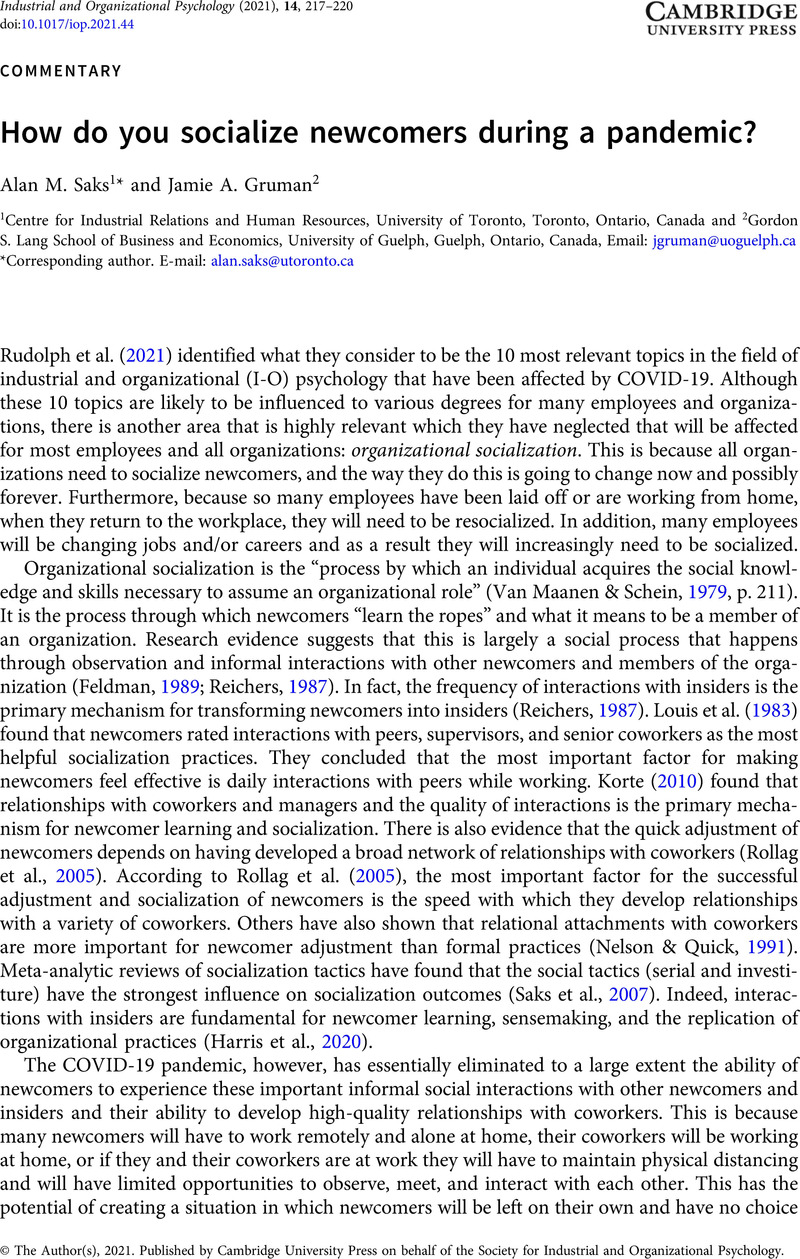Crossref Citations
This article has been cited by the following publications. This list is generated based on data provided by Crossref.
de Boer, Charlotte
and
Delobbe, Nathalie
2022.
Enseignement à distance dans une école de management hôtelier : conséquences sur les étudiants et ressources pour y faire face.
Raisons éducatives,
Vol. N° 26,
Issue. 1,
p.
237.
Jiang, Jane Yan
Ashforth, Blake E.
and
Li, Jia
2022.
The long walk together: The role of institutionalized socialization in shaping newcomers' future expectations about their networks.
Journal of Vocational Behavior,
Vol. 137,
Issue. ,
p.
103757.
2022.
Psychologie et carrières.
p.
307.
Delobbe, Nathalie
and
de Boer, Charlotte
2023.
Formation et socialisation organisationnelle.
Savoirs,
Vol. N° 63,
Issue. 2,
p.
11.
Sreya, B.
Lakshmana Rao, Ayyagari
Ramakrishnan, G.
and
Kulshretha, Nikhil
2023.
Emerging work environments in the pandemic era: a gendered approach to work-life balance programs.
Frontiers in Sociology,
Vol. 8,
Issue. ,
Stor, Marzena
2024.
The effects of staffing on company performance results: the mediating role of HRM outcomes in the specific contexts.
International Journal of Productivity and Performance Management,
Vol. 73,
Issue. 9,
p.
3054.
Pulman, Andy
and
Fenge, Lee-Ann
2024.
The Evolving Workplace: The Possible Impacts of Hybrid Working and Hotdesking on Retention of Social Workers.
The British Journal of Social Work,
Vol. 54,
Issue. 8,
p.
3755.
Kılıçarslan, Mustafa Gökhan
and
Reyhanoglu, Metin
2024.
SANAL İLETİŞİM, SANAL İŞ BİRLİĞİ VE ÖRGÜTSEL SOSYALLEŞME ARASINDAKİ İLİŞKİLERİN BELİRLENMESİ.
Mersin Üniversitesi Sosyal Bilimler Enstitüsü Dergisi,
Vol. 8,
Issue. 1,
p.
20.
Skountridaki, Lila
Lee, W. Victoria
and
Rouhani, Lilinaz
2024.
Missing voices: Office space discontent as a driving force in employee hybrid work preferences.
Industrial Relations Journal,
Vol. 55,
Issue. 1,
p.
54.
Basilio Ruiz de Apodaca, Oihana
Montes Gan, Vicente J
and
Moreno-Brieva, Fernando
2025.
Non-hierarchic leadership collaboration: Exploring the adoption of AI-driven social networking for addressing social challenges in an extra-organizational environment.
Technology in Society,
Vol. 81,
Issue. ,
p.
102809.
McCarthy, Julie M.
Erdogan, Berrin
Bauer, Talya N.
Kudret, Selin
and
Campion, Emily
2025.
All the Lonely People: An Integrated Review and Research Agenda on Work and Loneliness.
Journal of Management,
Ng, Eddy S.
Stanton, Pauline
Umeh, Chidozie
Bamber, Greg J.
Stone, Dianna
Lukaszewski, Kimberly
Aw, Sherry
Lyons, Sean
Schweitzer, Linda
Ren, Shuang
Özbilgin, Mustafa F.
and
Varma, Arup
2025.
Megatrends affecting the world of work: Implications for human resource management.
Personnel Review,
Karlsson, Matilde
Zaar Mårs, Olivia
Jenner, Bo
and
Frögéli, Elin
2025.
Effect of working remotely on new professionals’ learning and adjustment during the first five weeks after professional entry.
Journal of Workplace Learning,
Vol. 37,
Issue. 2,
p.
93.



